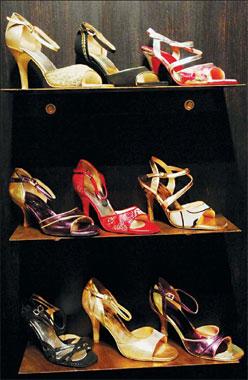
Buenos Aires' booming fashion industry makes it a key shopping window to Latin America. Quanjing
Acclaimed as the "Paris of South America", Buenos Aires - Argentina's capital and largest city - may beam with Old World elegance and 19th-century French mansions, but in recent years it also has blossomed as a vibrant design center.
Specializing in the fields of fashion, architecture, industrial, interior and urban design, makers here incorporate the markets' latest technologies and know-how.
In fact, this city on the tip of the Southeastern coast of South America is so significant to the market, it was chosen as UNESCO's first "City of Design" in 2005, and houses one of the most productive design industries in South America.
The city's booming fashion industry is focused on edgy style and leather goods, and women have long flocked to the elegance of its Recoleta neighborhood - known for its treasure of squares, parks, cafes and galleries - and home to prestigious labels including Hermes, Valentino, Ermenegildo Zegna, Fendi, Escada, Ralph Lauren, Salvatore Ferragamo, Nina Ricci, Hugo Boss, Christian Lacroix, Kenzo, Swarovski, Diesel and Louis Vuitton.
Armani, Rochas and Gianfranco Ferre all opened stores last year, while Carolina Herrera will arrive soon.
"These stores come to Buenos Aires because its citizens idolize foreign brands," proclaims Braulio Bauab, chief executive officer of BRAU Communication and Marketing, a brand consultant with clients like Dior, Tommy Hilfiger, Kenzo and others.
"Argentina is Latin America's shopping mall," explains Emiliano Fita, executive president of Wanama, a fashion brand with its own stores. "Over the last seven years, the country has had its biggest growth in its history regarding fashion and textile brands."
Motivated by the Argentine Apparel Industry Chamber, other associations, and the federal and municipal governments, Argentina's apparel industry continues to prosper throughout the country and the continent.
With domestic sales and exports of $12 billion, Argentina's apparel industry has annual production valued at $2.27 billion, according to the Argentine Apparel Industrial Chamber.
There are about 11,730 manufacturing and design companies producing garments, and 30,900 stores. The mass-market apparel sector has annual sales of about $5 billion a year, an amount expected to rise.
Retail sales in shopping malls around the city have rocketed since 2002 to $673 million. Malls have sprouted, with international labels from Zara to Tommy Hilfiger and Lacoste opening shops in exclusive properties like Galerias Pacifico and Patio Bullrich, which is being transformed into a luxe center with labels like Versace and Hugo Boss.
Fashion shows in town also have thrived: Buenos Aires Fashion Week, where local brands and designers launch collections twice a year, includes 30 fashion shows and drew 55,000 attendees in August.

Buenos Aires Moda, a smaller version of fashion week, holds about 10 shows annually, and Buenos Aires Alta Moda presents another 30 shows twice a year. With other private and smaller shows taking place, fashion sources estimate as many as 150 to 200 fashion shows are held in the city each year.
As a testament to the high style of the city, Alvear Avenue, the main thoroughfare in the Recoleta neighborhood, was cited by the NBC television network as among the top shopping streets in the world (after New York's Fifth and Madison Avenues, Paris' Champs Elysees and Oxford Street in London) because of its stores' high quality, glamour quotient and prices.
The area has become so popular, there is a waiting list to open stores there.
For more of the local flavor in apparel, one need only wander the streets of Palermo Soho, a fashion district crammed with boutiques, restaurants and bars that adopted its name from New York's SoHo neighborhood.
With exclusive Argentine fashions, high-quality leather products and trendy boutiques, Palermo Soho draws shoppers wandering its pastel-colored shops seeking Art Deco home accessories, leather shoes or indigenous designs like ponchos, saddle wear and other funky clothing.
Thanks to the region's design and competitive prices, Buenos Aires has become a key shopping window to Latin America. Tourists to Argentina - where prices dove after its economic crisis of 2002 - leave with armloads of merchandise from local malls. The currency crisis triggered a shopping rush to the capital, where an army of designers awaited.
As prices made Argentina more competitive in foreign markets, local designers began exporting brands and opened stores overseas.
The Tramando brand went international by selling roughly half its total annual production of 15,000 garments outside Argentina, at its store in New York and shops in Paris, Kuwait, Dubai, Istanbul, United Arab Emirates and Brazil.
Argentine designer Jessica Trosman exports her collection to the US, Japan, France, Spain, Russia, Switzerland, Dubai, Kuwait, China and Greece. She also recently signed with a Japanese company that pays her royalties.
Meanwhile, Wanama, which opened its first store in Buenos Aires in December 2001 in the midst of the financial setback, is a prime example of the fashion industry's growth in Argentina: Following the nation's economic recovery, the firm now has over 200 stores, with shops in Venezuela, Mexico, Guatemala and Peru.




